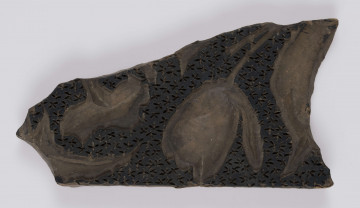
Block for printing on textile
1901 — 1950
National Museum in Lublin
Part of the collection: Fabric printing matrices
Textile printing stamps are wooden blocks that were used for imprinting designs by hand. They come in different shapes and have various designs. The presented stamp is covered with a convex pattern consisting of a triple twig motif with a small flower, arranged in a chequered pattern, often found on printing blocks. The pattern is made of brass pins and small plates stuck into the wood. These types of stamps were introduced late, only in the 19th century. Initially, the patterns were entirely carved in wood, but in time the metal elements were introduced which eventually completely replaced the engraved patterns. The use of pins and plates allowed making intricate designs and as a result, more interesting compositions. The stamp was used to decorate fabrics with batik technique. It involved printing the patterns with the use of insulating paste, the so-called resist which was used to cover the design. A stamp prepared this way was then pressed onto the fabric. To obtain an even pattern, the printer paid attention to the small dots left in the fabric by the nails placed at the corners of the block, which indicated where the stamp should be repositioned. The fabric covered with the pattern from the insulating mass was dipped several times into vats of dye and left to dry. Then, the resist was removed. The places where it used to be remained unpainted and contrasted with the colourful background. The batik printing technique has been known for a long time, but it was popularized in Europe only in the 17th century.
Author / creator
Dimensions
cały obiekt: height: 4,7 cm, width: 19,8 cm
Object type
matrix
Creation time / dating
Creation / finding place
Identification number
Location / status

1901 — 1950
National Museum in Lublin

1901 — 1950
National Museum in Lublin

1901 — 1950
National Museum in Lublin
DISCOVER this TOPIC
Museum of King Jan III's Palace at Wilanów
DISCOVER this PATH
Educational path